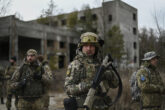April 29, 2019
Challenge Accepted: Why America Needs to Confront Its Adversaries in the Gray Zone
The return of great-power competition has dominated the national-security discussion in the United States since the release of the 2018 National Defense Strategy. However, little of it has been spent focusing on the previous era of great-power competition during the Cold War. Even a cursory exploration of that time-period will turn up documents that demonstrate the benefits of a better understanding of Cold War history. One example is a lecture delivered by the Chief of Naval Operations (CNO), Adm. Arleigh A. Burke, to the Naval War College in December of 1958.
The themes touched on by Admiral Burke’s address “The U.S. Navy’s Role in General War and Conflict Short of General War” still resonate today. The geopolitical situation it describes eerily resembles our present era. In fact, it’s not a stretch to say that with a few minor revisions the CNO could deliver the same address today. And while his blunt statement that the Sino-Soviet Bloc is America’s enemy might not survive in today’s political environment, his arguments are the same as those listed in the National Defense Strategy for classifying China and Russia as the United States’ primary competitors.
The National Defense Strategy states China and Russia are working to “shape a world consistent with their authoritarian model—gaining veto authority over other nations’ economic, diplomatic, and security decisions.” It also highlights China’s “all-of-nation long-term strategy” of economic coercion and influence operations and Russia’s subversive practices as a campaign designed to undermine the international order and change the “rules of the road.” Those conclusions rhyme with Admiral Burke’s earlier description of the Communist bloc’s fight against the Free World across “the fields of politics, of economics, of psychology, and of culture” to “disintegrate the institutions of the Free World.” Consequently, the geopolitical situation today can be viewed as merely a resumption of Cold War dynamics after a brief interruption. In this light, a close reading of Admiral Burke’s address provides a host of useful insights.
Read the full article in The National Interest.
More from CNAS
-
Ukraine Negotiations: Prospects and Pitfalls of Peace
This week Brussels Sprouts breaks down the latest negotiations on Ukraine. American officials told reporters that they had resolved or closed gaps around 90 percent of their d...
By Andrea Kendall-Taylor & Jim Townsend
-
Transatlantic Security / Middle East Security
The Russia-Iran Partnership: A Geopolitical Balancing ActIt has been almost a year since Russia and Iran signed their comprehensive strategic partnership. That deal established a 20-year partnership between the two countries coverin...
By Andrea Kendall-Taylor & Jim Townsend
-
Defense / Transatlantic Security
Ukraine’s Catch-22 MomentThis article was originally published in the Financial Times. In Joseph Heller’s wartime classic, Catch-22, the protagonist Yossarian seeks out the US army surgeon Doc Daneeka...
By Franz-Stefan Gady
-
Transatlantic Security / Middle East Security / Energy, Economics & Security
Sanctions Aren’t Enough to Shut Down the Moscow-Tehran Black Market for WarThe geographic scope and extent of Iranian-Russian cooperation highlights the failure of traditional sanctions to prevent Moscow and Tehran from seeking key components like ch...
By Delaney Soliday




